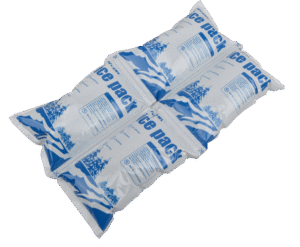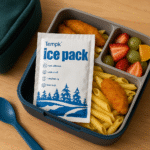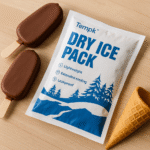Planning a camping trip and worried about keeping your food fresh? Dry ice packs are a game-changer for campers seeking extended freshness without the mess of melting ice. These packs offer superior cooling, are reusable, and are lightweight—ideal for outdoor adventures. In this guide, we’ll show you how dry ice packs elevate your camping experience, ensuring your perishables stay fresh for longer.

-
Understand how dry ice packs work for camping and why they are more effective than regular ice.
-
Compare dry ice with traditional ice and see why dry ice is the best choice for longer trips.
-
Learn how to choose the best dry ice pack for your trip, based on cooler size and trip duration.
-
Get essential safety tips for handling and storing dry ice during camping.
-
Explore the latest trends in camping cooling technology and how they integrate with dry ice solutions.
What Are Dry Ice Packs and How Do They Work?
Dry ice packs are reusable cooling solutions made from solidified carbon dioxide (CO₂). These packs are unique because they sublimate directly from solid to gas, meaning they don’t leave behind water, making them ideal for preventing soggy food and wet coolers.
How does this work?
-
Dry ice packs are much colder than regular ice, with a temperature of -78.5°C (-109.3°F), compared to 0°C (32°F) for regular ice.
-
They keep your food frozen for a longer duration—up to 2-3 days or more, depending on your cooler and packing method.
Benefits of Using Dry Ice Packs for Camping
-
Extended Freshness: Keep your food cold for longer without worrying about melting ice.
-
No Mess: Dry ice sublimates into gas, leaving no liquid residue to ruin your cooler or food.
-
Space-Efficient: Compact design allows more room in your cooler for other essentials.
-
Reusable: Most dry ice packs are designed for multiple uses, offering long-term value.
How Dry Ice Packs Compare to Regular Ice
Here’s a quick comparison between dry ice and regular ice for your camping trips:
| Factor | Dry Ice Packs | Regular Ice |
|---|---|---|
| Freezing Point | -78.5°C (sublimates) | 0°C (melts into water) |
| Duration | 2–3 days (or more) | 12–24 hours |
| Messiness | No water residue | Water can soak food and gear |
| Handling & Safety | Requires gloves, vented cooler | Safe, no special handling needed |
Takeaway: Dry ice packs provide long-lasting cooling without the mess of melting water, making them ideal for extended camping trips.
How to Choose the Right Dry Ice Pack for Your Camping Trip
When choosing dry ice packs for camping, consider the following factors:
-
Trip Duration: For shorter trips, smaller packs will suffice. For longer trips, opt for larger packs or custom-sized bricks.
-
Cooler Size: A larger cooler will need more dry ice to maintain a low temperature.
-
Type of Food: If you need to keep meats, frozen meals, or ice cream frozen, dry ice is your best bet. For drinks and less perishable items, regular ice might be enough.
Best Dry Ice Packs for Different Camping Scenarios
-
Weekend Camping (1-2 Days): 1–2 lb dry ice packs or small bricks work well.
-
Extended Camping (3+ Days): Larger 5 lb dry ice packs or PCM (phase change material) packs provide longer-lasting cooling.
How to Use Dry Ice Packs Safely While Camping
Safety Tips:
-
Wear gloves: Always handle dry ice with insulated gloves to prevent frostbite.
-
Ensure ventilation: Your cooler must allow gas to escape to avoid CO₂ buildup.
-
Avoid direct contact with food: Use insulation to prevent burns or freezing of food.
Packing Tips:
-
Pre-chill your cooler before packing it with frozen food and dry ice.
-
Layer dry ice packs at the bottom and middle of the cooler, with food on top.
-
Seal your cooler with a vented lid to allow the gas to escape safely.
Common Mistakes When Using Dry Ice for Camping
Avoid these common errors:
-
Underestimating the amount of dry ice needed for the trip.
-
Sealing the cooler too tightly, which prevents proper ventilation.
-
Placing dry ice directly on perishable food without insulation.
Pro Tip: Use Thermafreeze Cryosheets for insulation between dry ice and food to prevent cold burns.
2025 Trends in Camping Cold Chain Solutions
As we head into 2025, camping cooling solutions are becoming more efficient and eco-friendly. The trend is shifting towards using Phase Change Materials (PCMs) alongside dry ice to extend cooling power and reduce environmental impact. These sustainable alternatives are gaining popularity, providing campers with new ways to keep their food fresh for longer.
Latest Trends:
-
Eco-friendly materials: Companies are introducing biodegradable ice packs and using plant-based gels to reduce plastic waste.
-
Smart coolers: Some high-end coolers now feature temperature sensors that notify you when to add more cooling material.
-
Advanced insulation: Coolers with vacuum panels and improved foam materials help extend the lifespan of dry ice packs.
Frequently Asked Questions
Q1: Can I use dry ice packs in any cooler?
Yes, but your cooler should be well-ventilated to allow CO₂ gas to escape. Insulated coolers like YETI work best.
Q2: How long will dry ice packs keep my food cold?
Dry ice packs can keep food cold for 1–3 days, depending on the cooler’s insulation and the size of the pack.
Q3: Are dry ice packs safe for food?
Yes, dry ice packs are food-safe when used correctly with insulation layers to avoid direct contact.
Conclusion
Dry ice packs are a must-have for any camping trip, offering long-lasting cooling without the mess of melting ice. Whether you’re planning a weekend getaway or a week-long adventure, these packs will keep your food fresh and safe. Remember to follow proper packing and safety guidelines to maximize their effectiveness.
About Tempk
Tempk specializes in high-quality dry ice and PCM solutions for camping and outdoor adventures. Our products are designed for durability and efficiency, ensuring your food stays cold for days without hassle.
Call to Action: Explore Tempk’s range of dry ice packs and enhance your camping experience today! Need tailored advice? Request a free consultation now.























